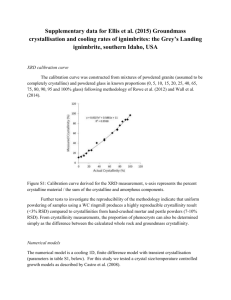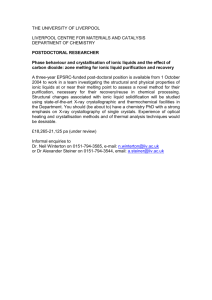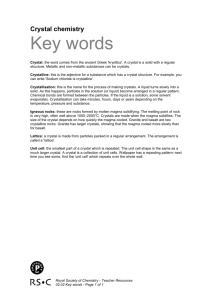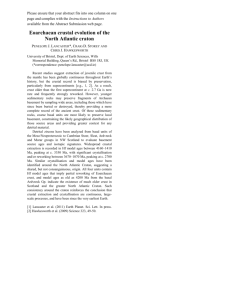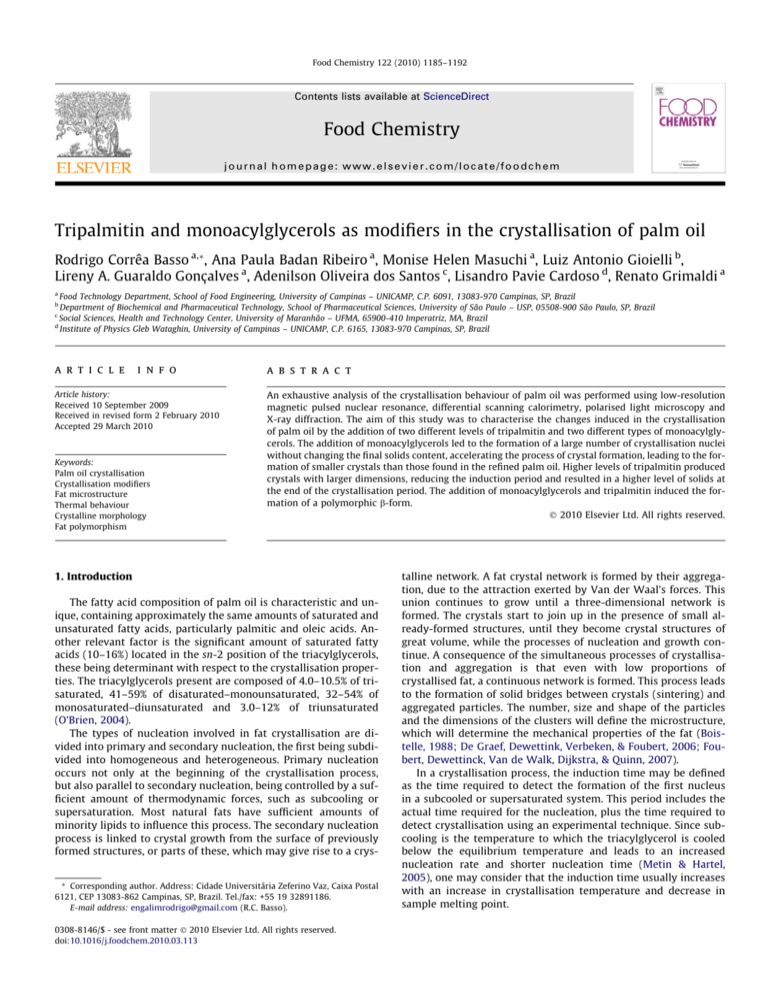
Food Chemistry 122 (2010) 1185–1192
Contents lists available at ScienceDirect
Food Chemistry
journal homepage: www.elsevier.com/locate/foodchem
Tripalmitin and monoacylglycerols as modifiers in the crystallisation of palm oil
Rodrigo Corrêa Basso a,*, Ana Paula Badan Ribeiro a, Monise Helen Masuchi a, Luiz Antonio Gioielli b,
Lireny A. Guaraldo Gonçalves a, Adenilson Oliveira dos Santos c, Lisandro Pavie Cardoso d, Renato Grimaldi a
a
Food Technology Department, School of Food Engineering, University of Campinas – UNICAMP, C.P. 6091, 13083-970 Campinas, SP, Brazil
Department of Biochemical and Pharmaceutical Technology, School of Pharmaceutical Sciences, University of São Paulo – USP, 05508-900 São Paulo, SP, Brazil
c
Social Sciences, Health and Technology Center, University of Maranhão – UFMA, 65900-410 Imperatriz, MA, Brazil
d
Institute of Physics Gleb Wataghin, University of Campinas – UNICAMP, C.P. 6165, 13083-970 Campinas, SP, Brazil
b
a r t i c l e
i n f o
Article history:
Received 10 September 2009
Received in revised form 2 February 2010
Accepted 29 March 2010
Keywords:
Palm oil crystallisation
Crystallisation modifiers
Fat microstructure
Thermal behaviour
Crystalline morphology
Fat polymorphism
a b s t r a c t
An exhaustive analysis of the crystallisation behaviour of palm oil was performed using low-resolution
magnetic pulsed nuclear resonance, differential scanning calorimetry, polarised light microscopy and
X-ray diffraction. The aim of this study was to characterise the changes induced in the crystallisation
of palm oil by the addition of two different levels of tripalmitin and two different types of monoacylglycerols. The addition of monoacylglycerols led to the formation of a large number of crystallisation nuclei
without changing the final solids content, accelerating the process of crystal formation, leading to the formation of smaller crystals than those found in the refined palm oil. Higher levels of tripalmitin produced
crystals with larger dimensions, reducing the induction period and resulted in a higher level of solids at
the end of the crystallisation period. The addition of monoacylglycerols and tripalmitin induced the formation of a polymorphic b-form.
Ó 2010 Elsevier Ltd. All rights reserved.
1. Introduction
The fatty acid composition of palm oil is characteristic and unique, containing approximately the same amounts of saturated and
unsaturated fatty acids, particularly palmitic and oleic acids. Another relevant factor is the significant amount of saturated fatty
acids (10–16%) located in the sn-2 position of the triacylglycerols,
these being determinant with respect to the crystallisation properties. The triacylglycerols present are composed of 4.0–10.5% of trisaturated, 41–59% of disaturated–monounsaturated, 32–54% of
monosaturated–diunsaturated and 3.0–12% of triunsaturated
(O’Brien, 2004).
The types of nucleation involved in fat crystallisation are divided into primary and secondary nucleation, the first being subdivided into homogeneous and heterogeneous. Primary nucleation
occurs not only at the beginning of the crystallisation process,
but also parallel to secondary nucleation, being controlled by a sufficient amount of thermodynamic forces, such as subcooling or
supersaturation. Most natural fats have sufficient amounts of
minority lipids to influence this process. The secondary nucleation
process is linked to crystal growth from the surface of previously
formed structures, or parts of these, which may give rise to a crys-
* Corresponding author. Address: Cidade Universitária Zeferino Vaz, Caixa Postal
6121, CEP 13083-862 Campinas, SP, Brazil. Tel./fax: +55 19 32891186.
E-mail address: engalimrodrigo@gmail.com (R.C. Basso).
0308-8146/$ - see front matter Ó 2010 Elsevier Ltd. All rights reserved.
doi:10.1016/j.foodchem.2010.03.113
talline network. A fat crystal network is formed by their aggregation, due to the attraction exerted by Van der Waal’s forces. This
union continues to grow until a three-dimensional network is
formed. The crystals start to join up in the presence of small already-formed structures, until they become crystal structures of
great volume, while the processes of nucleation and growth continue. A consequence of the simultaneous processes of crystallisation and aggregation is that even with low proportions of
crystallised fat, a continuous network is formed. This process leads
to the formation of solid bridges between crystals (sintering) and
aggregated particles. The number, size and shape of the particles
and the dimensions of the clusters will define the microstructure,
which will determine the mechanical properties of the fat (Boistelle, 1988; De Graef, Dewettink, Verbeken, & Foubert, 2006; Foubert, Dewettinck, Van de Walk, Dijkstra, & Quinn, 2007).
In a crystallisation process, the induction time may be defined
as the time required to detect the formation of the first nucleus
in a subcooled or supersaturated system. This period includes the
actual time required for the nucleation, plus the time required to
detect crystallisation using an experimental technique. Since subcooling is the temperature to which the triacylglycerol is cooled
below the equilibrium temperature and leads to an increased
nucleation rate and shorter nucleation time (Metin & Hartel,
2005), one may consider that the induction time usually increases
with an increase in crystallisation temperature and decrease in
sample melting point.
1186
R.C. Basso et al. / Food Chemistry 122 (2010) 1185–1192
Monoacylglycerols assume an important role in the crystallisation process. In some cases, when they are present at high levels or
low temperatures, they generally contribute to the crystallisation
process by increasing both the number of crystals and the nucleation rate. On the other hand, when they are present at low levels
or higher temperatures, they will slow the crystallisation process
down in a lipid material (Foubert, Vanhoutee, & Dewettinck, 2004).
Triacylglycerols levels in binary mixtures affect their crystallisation behaviour. Both the thermal behaviour observed by DSC and
the polymorphism value by X-ray diffraction have changed for different fractions of tripalmitin blended with 1,3-dipalmitoyl-2oleoyl-glycerol (POP) and 1,2-dioleoyl-3-palmitoyl-glycerol (POO)
(Mihara, Ishiguro, Fukano, Taniuchi, & Ogino, 2007).
The lipid composition and crystallisation conditions influence
the crystal format, and different polymorphic forms and crystal
morphologies are possible. The crystals are aggregated into larger
structures forming a network, which characterises the fat microstructural level. The type of polymorph characteristic of a fat or
oil is dependent on the distribution of fatty acids in the triacylglycerol molecule, and the degree of randomisation is particularly
important. In turn the microstructure concept includes information about the state, quantity, shape, size, spatial relationship
and interaction amongst all the components of the crystalline network, and has an enormous influence on the macroscopic properties of the fats (Marangoni & Hartel, 1998; Ribeiro et al., 2009; Shi,
Liang, & Hartel, 2005).
Although there are explanations about the mechanisms that
determine the crystal type formed, there is little information about
the way the presence of some compounds modifies crystal polymorphism. Knowledge of this effect could make it possible to control palm oil crystallisation, leading to its application in a huge
variety of products and processes. The objective of this study was
to make a complete characterisation of the changes caused in the
crystallisation behaviour of refined palm oil by the addition of
monoacylglycerols with different fatty acid compositions and
two different levels of tripalmitin. The characterisation was made
considering the thermogram and isothermal crystallisation, the
kinetics and morphology of crystal formation and the polymorphic
changes that occurred.
2. Materials and methods
2.1. Materials
Refined, bleached and deodorised palm oil (Po) were provided
by national industry. Tripalmitin (PPP), 99% purity, was provided
by Sigma–Aldrich (St. Louis, MO). Monoacylglycerols of fully
hydrogenated palm oil (MP), 90% of theoretical purity and monoacylglycerols of behenic acid (MBe), 90% of theoretical purity, were
used as commercial samples.
2.2. Sample preparation
2.2.1. Addition of acylglycerols
Four palm oil samples were prepared by adding tripalmitin
(two different levels) and monoacylglicerols (behenic acid and full
hydrogenated palm oil) to a Po sample.
Two different levels of PPP were added (5.7% and 11.4% of Po
sample mass), resulting in final tripalmitin contents of 13.6%
(PoTp1) and 17.8% (PoTp2). The palm oil samples were previously melted, tripalmitin was weighed on an analytical balance
and added to the tubes with palm oil. The systems were shaken
in shaker tubes for 30 s, heated at 100 °C for 30 min and shaken
again for 30 s at around 100 °C, to ensure complete
homogenisation.
Following the above procedure, 1.01% (m/m) of MP or MBe was
added, resulting in PoMp and PoMBe samples, respectively, each
one with 1.0% of monoacylglycerols regarding the final mass.
2.3. Analytical methodology
2.3.1. Triacylglycerol composition
Triacylglycerol composition was measured based on AOCS CE 586 (2004) methodology, determined by an Agilent capillary gas
chromatography system, Series 6850, with flame ionisation detector (FID), and an Agilent DB-17 capillary column (50% phenylmethylpolysiloxane; length 15 m, internal diameter 0.25 mm and
0.15 lm film thickness). Flow rate was 1.0 ml/min, linear velocity
of 40 cm/s, with a detector temperature of 375 °C, injector temperature of 360 °C, oven temperature from 250 to 350 °C (5 °C/min),
followed by 350 °C for 20 min, carrier gas of helium; injected volume of 1.0 ll with 1:100 split. Retention times were determined
comparing with commercials standards, samples and others vegetable oils (palm oil, soybean oil, and palm kernel oil) previously
indentified and quantified in our laboratory. All fractions of triacylglycerols in palm oil were quantified based on relative peak area, in
duplicate. The results were compared with those obtained following the procedure of Antoniosi Filho, Mendes, and Lanças (1995)
and with a literature compilation (Andrikopoulos, 2002).
2.3.2. Fatty acid composition of the monoacylglycerols
Fatty acid composition was determined in duplicate by an Agilent capillary gas chromatography system, Series 6850, FID detector, with an Agilent DB-23 capillary column (50% cyanopropylmethylpolysiloxane; length 60 m, internal diameter 0.25 mm and
0.2 lm film thickness). Flow rate was 1.0 ml/min, linear velocity
of 24 cm/s, with a detector temperature of 280 °C, injector temperature of 250 °C, oven temperature: 110 °C for 5 min, 110–215 °C
(5 °C/min), 215 °C for 34 min, helium carrier gas; injected volume
of 1.0 ll, 1:50 split. Methylation reaction was done using NH4Cl
in methanol solution. In fatty acid methyl esters (FAME) separation
saturated salt solution and petroleum ether were used according to
the methodology proposed by Hartman and Lago (1973). FAME in
petroleum ether were transferred into vials and analysis was done
in duplicate. Individual components were identified by comparison
with commercial FAMES standards, and other FAMES from vegetable oils (palm oil, soybean oil, and palm kernel oil) prepared, identified and quantified in laboratory previously. Fatty acids were
quantified based on relative peak areas.
2.3.3. Isothermal crystallisation
The samples were melted in an oven and kept in an incubator
for 15 min at 100 °C to ensure destruction of the crystalline forms.
After removing from the oven, the samples were placed in a dry
static thermal bath with the temperature controlled by a Duratech
tcon Peltier system (temperature range from 5 to 70 °C) at a temperature of 70 °C for 1 h (Campos, 2005). After this period, they
were subjected to a temperature of 25 °C and readings of the solids
contents taken every 60 s, using low-resolution magnetic pulsed
nuclear resonance equipment (NMR) (Minispeq mq 20, Bruker; Silberstreifen, Rheinstetten, Germany), until the solids level became
stable.
2.3.4. Differential scanning calorimetry
The equipment used was a Perkin–Elmer Delta Series Model
DSC 7 differential scanning calorimeter (DSC) of the power compensation type (Waltham, MA). The samples were previously
melted and weighed (about 3–10 mg) in aluminium pans, and covers were sealed into place. An empty sealed aluminium pan was
used as reference in the other DSC oven. A baseline was obtained
with an empty sealed aluminium pan prior to analysis of samples.
R.C. Basso et al. / Food Chemistry 122 (2010) 1185–1192
The samples were subjected to the following temperature program: heated to 80 °C and maintained at isothermal conditions
for 10 min, cooling to a temperature of 40 °C at a rate of 10 °C/
min. DSC values reported are the average of three scans. The manufacturer’s software (Pyris Manager 2.04/windows) was used in
thermal analysis.
2.3.5. Polarised light microscopy
The samples were melted at 70 °C and a drop transferred onto a
glass slide with the aid of a capillary tube. The drop was covered
with a pre-heated cover slip before transferring to an incubator
at 25 °C and maintaining at this temperature for a period of 20 h.
After this period, the slides were transferred to a plate at a temperature of 25 °C (Mettler Toledo, FP82 Microscope Hot Stage). With
the aid of a polarised light microscope (Olympus, model BX 50)
connected to a digital video camera (Media Cybernetics), images
were taken from three different visual fields at a magnification of
40, and then a single image selected for the analysis (Gamboa
& Gioielli, 2006). The Image-Pro Plus software, Version 4.5.1.22
(Media Cybernetics) was used to take the images and carry out
the quantitative analysis of the results. The analysis parameter
chosen was the maximum diameter of the crystal (greatest length
on a given axis).
2.3.6. X-ray diffraction
The crystalline polymorphic form of palm oil was determined
according to the AOCS Cj 2-95 (2004) method. The tests were performed in a Philips (PW1710) diffractometer; Bragg_Bretano
geometry (h:2h); Cu Ka radiation (k = 1.54056 Å, at 40 kV and
30 mA). The measurements were performed with a 0.02° step in
2h, with an acquisition time of 2 s, over the range from 5° to 40°
(2h scale). Diffraction was performed at a temperature of 20 °C, sufficient to ensure crystallinity of the samples. The crystalline forms
were identified from their characteristic short spacing, calculated
using the Bragg Law:
k ¼ 2d sin h
ð1Þ
where k is the wavelength of the X-ray emitted, d is the short spacing and h is the angle of diffraction. The a-form is characterised by a
single line of diffraction at 4.15 Å. The b0 -form is characterised by
two lines of diffraction at 3.8 and 4.2 Å or 4.27, 3.97 and 3.71 Å or
3.9 and 4.3 Å. The b-form is associated with a number of diffraction
lines, predominantly at 4.6 Å, and lines of lower intensity, including
those at 3.9 and 3.8 Å. The sub-b-form may be characterised by a
strong peak for a short spacing of 4.73 Å or three intermediate
peaks at 4.5, 3.9 and 3.6 Å (AOCS, 2004; Cerdeira, Martini, Candal,
& Herrera, 2006; D’Souza, deMan, & deMan, 1990; Yap, de Man, &
de Man, 1989). The b- and b0 -form contents in the samples were
estimated by the relative intensity of the short spacing (AOCS,
2004; Che Man, Shamsi, Yusoff, & Jinap, 2003; Szydlouska-Czerniak,
Karlovits, Lach, & Szlyk, 2005).
2.3.7. Statistical analysis
DSC data were statistically analysed by one-way analysis of variance (ANOVA) with Statistica (V.6) Software (Statsoft Inc., Tulsa,
OK) Software. Tukey test was applied to determine significant differences between means, at a level of p < 0.05.
3. Results and discussion
3.1. Triacylglycerol composition
The triacylglycerol composition of the palm oil was 9.7 ± 0.22,
50.2 ± 0.6, 35.7 ± 0.49 and 4.3% ± 0.14 of trisaturated, disaturated–monounsaturated, monosaturated–diunsaturated and triunsat-
1187
urated fractions, respectively. The tripalmitin content was
8.5% ± 0.11.
3.2. Fatty acid characterisation of the monoacylglycerols
The monoacylglycerol samples were characterised in relation to
their fatty acid compositions. The primary fatty acids of the MP
sample were C16:0 and C18:0, in proportions of 45.4 ± 0.05 and
53.6% ± 0.05, respectively. In turn, the MBe sample contained the
fatty acids C18:0, C20:0 and C:22:0, with respective percentages
of 3.6 ± 0.01, 6.9 ± 0.01 and 85.5% ± 0.02.
3.3. Crystallisation kinetics
As can be seen in Fig. 1, the induction time was reduced from 33
to 15 and 12 min, respectively, for Po, PoTp1 and PoTp2, suggesting
an increase in the crystallisation rate of the samples with added
tripalmitin.
The crystallisation behaviour of palm oil was changed by the
addition of tripalmitin, a triacylglycerol present in significant
amounts in some oils and in the stearin fraction of some fractionated oils, causing anticipation of its crystallisation when subjected
to an isothermal condition.
The addition of 1% of monoacylglycerol to palm oil showed a
significant effect in reducing the induction time, as shown in
Fig. 1. The induction times decreased from 33 to 19 and 13 min,
respectively, for PoMp and PoMBe. The addition of MBe to Po
showed a greater decrease in induction time than when the same
proportion of MP was added.
Monoacylglycerols act as crystallisation inducers, serving as a
nucleation seed and consequently facilitating aggregation of the
triacylglycerol molecules, thus reducing the induction process
time. The presence of these partial acylglycerols did not lead to significant changes in the final solids content after isothermal crystallisation, which is in agreement with the results obtained by
Wright, Hartel, Narine, and Marangoni (2000), who found that
acceleration of the crystallisation speed by the presence of minor
compounds did not necessarily affect the final solid fat content
in an isothermal process.
In a study of the interaction of partial acylglycerols and triacylglycerols in milk fat, Foubert et al. (2004) reported two mechanisms of interaction with the triacylglycerol crystals. The first
resulted in slower crystal growth, due to competition in binding
with the triacylglycerols. The second form involved organisation
in a micellar structure of partial acylglycerols, acting as nucleation
facilitators, as described by Savage and Dimick (1995) and Skoda
and Van de Tempel (1967), reducing the induction time and
increasing the number of crystalline nuclei.
The addition of higher levels of monostearin to milk fat accelerated the crystallisation process at lower temperatures, while lower
levels associated with higher temperatures delayed the crystallisation process. Distearin provoked a general delay in the crystallisation process. On the other hand, higher levels of monoolein and
diolein increased the crystal growth speed, resulting in a less pronounced effect on the induction time (Foubert et al., 2004).
In a study carried out by Niiya, Maruyama, Imamura, Okada,
and Matsumoto (1973) with hydrogenated fat, increases in the
crystallisation rate, melting point and solid fat content were reported with the addition of saturated monoacylglycerols, such as
monopalmitin, monostearin and monobehenin, the effect of the
latter predominating over the others in causing rises in the melting
point and solids content.
Monoacylglycerol behenic acids are probably more effective as
crystallisation inducers, due to the presence of a longer fatty acid
chain than those found in high proportions in the monoacylglycerols of the fully hydrogenated palm oil (palmitic and stearic acids),
R.C. Basso et al. / Food Chemistry 122 (2010) 1185–1192
SFC (%)
1188
26
24
22
20
18
16
14
12
10
8
6
4
2
0
0
10
20
30
40
50
60
70
time (min)
Fig. 1. Isothermal crystallisation of refined palm oil, refined palm oil with added tripalmitin and refined palm oil with added monoacylglycerols at 25 °C: (e) Po; (h) PoTp1,
(N) PoTp2, (–) PoMp, and () PoMBe.
leading to greater stability at the crystallisation seed-forming
temperature.
3.4. Thermal behaviour
The results of one-way analysis of variance (ANOVA) indicated
that, for the Po sample, the addition of tripalmitin and monoacylglycerols changed significantly the beginning of the crystallisation
process (Tonset), the temperature at which the exothermal effect is
maximum (Tpeak) and the energy released by the crystallisation
process (enthalpy) on the stearin fraction. No significant differences were observed comparing PoTp1 and PoMp, with respect
to Tonset. In the same way, PoTp1 and PoMbe did not show significant differences concerning Tpeak.
Fig. 2 shows two distinct exothermic peaks during the crystallisation process of the Po sample. The first, located in the region of
higher temperatures, between 31 and 15 °C in the different thermograms, represented the crystallisation phase rich in saturated
triacylglycerols, the stearin fraction. The second, between 10 and
12 °C, represented the crystallisation process of the phase rich
in unsaturated triacylglycerols, the olein fraction, which corroborates the observations of Tan and Che Man (2000), who described
the formation of two distinct peaks in the DSC analysis of palm oil.
Acceleration of the crystallisation process in the samples with
added tripalmitin and monoacylglycerols may be observed by the
displacement of the Tonset and the Tpeak, referring to stearin in the
region of higher temperatures. As can be seen in Table 1, the start
of crystallisation of the Po was early in proportion to the addition
of tripalmitin. The presence of MBe resulted in a greater change in
the Po crystallisation temperature, by 2.9 °C, whereas with MP it
was only by 1.6 °C.
Increasing the crystallisation temperature by the addition of
PPP is in agreement with the results of studies by Che Man, Haryati, Ghazali, and Asbi (1999) on the thermal behaviour of crude
palm oil and its derivatives, in which the crystallisation peaks of
the compounds containing more saturated triacylglycerols moved
Fig. 2. Thermogram crystallisation of refined palm oil, refined palm oil with added tripalmitin and refined palm oil with added monoacylglycerols: Po; PoTp1; PoTp2; PoMp;
PoMBe.
1189
R.C. Basso et al. / Food Chemistry 122 (2010) 1185–1192
Table 1
Crystallisation temperatures and exothermic peaks of refined palm oil and its blends with tripalmitin and monoacylglycerols.
Tonset (°C)
Tpeak (°C)
Area (J/g)
Po
PoTp1
PoTp2
PoMP
PoMBe
24.37 ± 0.31
20.17 ± 0.81
3.99 ± 0.42
25.83 ± 0.06
24.80 ± 0.00
19.3 ± 0.03
29.71 ± 0.14
27.41 ± 0.19
23.08 ± 0.38
26.00 ± 0.44
23.63 ± 0.35
8.73 ± 0.23
27.3 ± 0.36
25.03 ± 0.21
13.10 ± 0.26
to the region of higher temperatures. According to Toro-Vazquez,
Briceno-Montelongo, Dibildox-Alvarado, Charo-Alonso, and ReysHernandez (2000), who studied the crystallisation kinetics of palm
stearin in sesame oil, the tripalmitin was primarily responsible for
increasing the crystallisation temperature of this blend.
Samples with added tripalmitin led to the release of more heat
during the crystallisation of the phase rich in saturated triacylglycerols. On the other hand, the addition of monoacylglycerols in
spite of increasing the crystallisation temperature produced a lower increase in the release of energy during the crystallisation process relative to tripalmitin (Table 1). A great increase in the
release of heat during the crystallisation process may be detrimental, since it may result in elevated temperatures that will cause the
dissolution of already-formed crystals. Wassell and Young (2007)
mentioned the addition of small amounts (1–2%) of saturated triacylglycerols as a cheap and effective alternative to induce the start
of the crystallisation process.
3.5. Crystalline morphology and microstructure
The minimum and maximum values for maximum crystal
diameter at 25 °C were 53 and 128, 55 and 142, 56 and 118, 7
and 99, and 25 and 51 lm, respectively, for Po, PoTp1, PoTp2,
PoMp and PoMBe.
It can be seen that the minimum values for the crystal diameter
of Po, PoTp1 and PoTp2 were very close to 50 lm, indicating that
raising the PPP level did not cause an increase in the smallest crystal diameter formed in palm oil. Higher PPP levels led to the formation of larger amounts of crystals with relatively homogeneous size
and form. A small number of clusters can be observed in PoTp2
(Fig. 3).
It can be seen from the Po, PoMp and PoMBe samples that the
addition of monoacylglycerols induced the formation of large numbers of small crystalline nuclei, in agreement with that described
by Foubert et al. (2004) who reported an increase in the amount
of crystallisation seed and in the number of crystals formed and
a decrease in the induction period, due to the influence of existing
partial acylglycerols. The minimum diameter values, 7 and 25 lm,
were much lower than those obtained for Po in the absence of
monoacylglycerols.
Monoacylglycerols play the role of crystallisation seeds, dispersed in the palm oil. Triacylglycerol molecules are adsorbed onto
the surface of these structures and then the crystallisation process
begins. A large number of seeds results in smaller crystals, since
the triacylglycerols are distributed during their adsorption and
crystallisation.
As seen in Fig. 3, the addition of monoacylglycerols of behenic
acid resulted in the formation of a structured network composed
of clusters of homogeneous crystals. However, the presence of
palm-based monoacylglycerols, while increasing the amount of
crystals, did not lead to the formation of a structured network,
showing great diversity in their diameter.
The crystallisation occurring from the formation of a large number of small crystalline nuclei could be one of the causes of the
lower energy release during this process, since the samples showing lower exothermic peaks during the process possessed the
smallest crystal diameters. The energy released during the forma-
tion of larger crystals seems to be greater than that released during
the formation of smaller crystals, even when in significantly larger
numbers.
The addition of saturated monoacylglycerols leads to the formation of a greater number of crystallisation seeds, possibly more stable to the effect of temperature. During the crystallisation process,
a crystalline network is formed that allows for greater interaction
between triacylglycerol molecules, between which intermolecular
attractive forces such as the Van der Waal’s forces can act, which
may promote greater intermolecular attraction, leading to a decrease in system solubility, more evident at high temperatures,
contributing to the crystallisation process.
3.6. Avrami model
The Avrami model is the one most commonly used to study the
crystallisation of fats and may be used to assess the crystallisation
kinetics and suggest the nature of crystal growth. The model takes
into account that crystallisation occurs by nucleation and by crystal growth and is based on the isothermal transformation conditions, random spatial growth and the kinetics of the system, in
which the growth speed of the new phase depends solely on temperature. The Avrami equation is presented in the following way:
n
SFC
¼ 1 ekt
SFC max
ð2Þ
where n is the Avrami exponent (dimensionless), k is the Avrami
constant, SFC is the solids content at a given time and SFCmax is
the maximum level of solids at a given temperature.
The half life of crystallisation, t1/2, reflects the magnitude of k
and n according to the equation:
tð1=2Þ ¼
1=n
ln 2
k
ð3Þ
The constant k represents the rate of crystallisation, while the
exponent n, known as the crystallisation index, indicates the mechanism of crystal growth. The parameter n is a combination function
of a time-dependent nucleation and number of potential growth
dimensions (Marangoni, 2005).
Nucleation may be sporadic or instantaneous and crystal
growth may be one, two- or three-dimensional, characterising
the formation of needles, disks or spherulites, respectively, as the
crystalline forms. Values of n = 3 correspond to an instantaneous
or sporadic nucleation spherulite form or to a sporadic nucleation
disk form, while values of n = 2 correspond to the sporadic growth
of needle-like forms or the instantaneous nucleation of disk-like
growth. Although n should be a whole number, fractional values
are commonly obtained. This event is primarily related to the formation of crystals with similar morphology from different types of
nucleation (sporadic or instantaneous). Fractional values of the
exponent n may be explained by the simultaneous development
of crystals with different morphologies (Marangoni, 2005).
The parameters of the Avrami model were calculated based on
the results from isothermal crystallisation at 25 °C, considering the
time interval occurring when the induction period ends, up to
10 min after stabilisation of the solid fat content.
1190
R.C. Basso et al. / Food Chemistry 122 (2010) 1185–1192
Fig. 3. Microscopic images under polarised light at 25 °C of refined palm oil, refined palm oil with added tripalmitin and refined palm oil with added monoacylglycerols: Po;
PoTp1; Po2Tp2; PoMp; PoMBe. The bar represents 200 lm.
From the k-values reported in Table 2, it can be observed that
the crystallisation rates increase with the percentage of PPP. Of
the samples with added monoacylglycerols, PoMBe showed higher
crystallisation rates than PoMp, confirming the greater effectiveness of the monoacylglycerols of behenic acid as accelerators of
the crystallisation process, as compared to palm-based monoacylglycerols. Both the samples with added tripalmitin and with added
monoacylglycerols showed higher rates of crystallisation than Po.
Table 2
Avrami model parameters for the crystallisation of refined palm oil and its blends
with tripalmitin and monoacylglycerols at 25 °C.
k (minn)
n
R2
t½
Po
PoTp1
PoTp2
PoMP
PoMBe
1.72E07
3.9
0.96
48.8
4.60E05
3.0
0.96
24.4
8.91E04
2.4
0.90
16.5
1.41E06
4.1
0.81
24.8
4.05E04
2.6
0.81
18.0
These results agree with those found for the value of the half life
of crystallisation.
From the exponent n, observed in Table 2, a tendency for crystal
formation of the spherulite type for Po can be noticed. The addition
of 1% of palm-based monoacylglycerols did not change the crystal
morphology, since crystals of the spherulite type continued to
form. Although the n-value obtained for PoTp2 was 2.4, Fig. 3
shows the formation of spherulites. For PoTp2 and PoMBe, the nvalues suggest a transition from two-dimensional growth, disc
type, to three-dimensional growth, spherulite type.
3.7. Crystalline polymorphism
From the X-ray diffractograms in Fig. 4, the absence of peaks for
a short spacing of 4.6 Å and the presence of an intense peak showing crystals with a short spacing of 4.2 Å can be seen for Po, where
crystals with a short spacing of 3.8 Å can also be observed. This
configuration characterises the absence of b-crystals and the
R.C. Basso et al. / Food Chemistry 122 (2010) 1185–1192
1191
Smith, Furó, and Smith (2007) described the action of partial
acylglycerols in the modification of crystal morphology, by binding
them to a crystalline face and preventing deposition of triacylglycerol molecules on that surface, reducing crystalline growth in this
region. Wright and Marangoni (2003) also stated that when impurities were present in a fat crystal, they generally modified the
growth of certain faces, changing the morphology of the crystalline
structures. Even so, the authors found no changes in the crystalline
morphology of milk fat due to the removal of minor compounds or
the addition of diacylglycerols.
Timms (1984) relates the b0 -form to the asymmetry of the triacylglycerol molecule in the presence of saturated and unsaturated
fatty acids. Similarly, the b-form is related to the symmetry of triacylglycerols, both in the occupancy of the 1,3 positions and in the
occupancy of all three positions by fatty acids of similar structures.
This statement confirms the increase in the polymorphic b-form
and the decline in b0 with the addition of tripalmitin, a completely
symmetrical triacylglycerol.
Monoacylglycerols of fully hydrogenated palm oil favoured the
formation of b-crystals without leading to the removal of b0 -crystals, which makes it an important inducer of the crystallisation
process of fats in the food industry. Nevertheless, the addition of
tripalmitin and monoacylglycerols of behenic acid as accelerators
of the crystallisation process of palm oil, leading to b-crystal formation, may be very important in the chocolate industry, where
this type of crystal is desired.
Fig. 4. Diffractograms of refined palm oil, refined palm oil with added tripalmitin
and refined palm oil with added monoacylglycerols at 20 °C: Po; PoTp1; PoTp2;
PoMp; PoMBe.
0
strong presence of b crystals. In a similar way, Braipson-Danthine
and Gibon (2007) demonstrated the diffraction lines of the b0 -form
for palm oil at 20 °C, with peaks of low intensity suggesting short
spacings of 4.32 and 4.12 Å and peaks of high intensity in the short
spacings of 3.88 and 4.20 Å, close to those obtained in the present
paper.
The addition of tripalmitin induced the formation of polymorphic b-form crystals, and the amount of b-crystals formed was in
proportion to the addition of tripalmitin, as can be seen from the
increase in intensity of the diffraction peak for a short spacing of
4.6 Å, characteristic of PoTp1 to PoTp2.
The addition of monoacylglycerols also led to a change in the
polymorphic form of the crystals present in palm oil. The presence
of MP led to the formation of b-type crystals. When MBe was
added, peaks for b-crystals appeared and a sub-b transitional form
could also be observed, indicated by short spacings of, respectively,
4.6 and 3.9 Å. Adding 1% of fully hydrogenated palm-based monoacylglycerols also caused the formation of b-crystals, despite coexisting with a higher content of b’-crystals, since a relatively intense
peak for a short spacing of 4.2 Å can be observed.
The decreasing intensity of the peaks related to the b0 -form and
simultaneous increase in the intensity of the b peaks and appearance and increase in intensity of peaks related to a transition of
the sub-b form, indicated by, respectively, short spacings of 4.5
and 3.9 Å, shows the effect of PPP in facilitating the transition to b.
Mazzanti, Guthrie, Sirota, Marangoni, and Idziak (2004) reported that the formation of the b-phase was largely dependent
on a previously formed a-phase. The polar lipids (acylglycerols)
act as crystallisation sites for the induction of crystallisation in
the initial a-phase. From this previously formed a-stage, the triacylglycerols could switch to a b-phase, due to increased stability
of the crystalline arrangement. However, the absence of polar lipids allows for freer accommodation of the triacylglycerol molecules
in the b0 -form, inducing a quick transition from the a to the b0 form.
4. Conclusions
The palm oil crystallisation process may be changed by adding
tripalmitin and monoacylglycerols. The addition of tripalmitin
heightened the speed of crystallisation, the increase in solids content, the release of thermal energy, the increase in size of the triacylglycerol crystals and the formation of b-crystals. In turn, the
addition of monoacylglycerols accelerated the crystallisation of
palm oil by increasing the number of crystallisation seeds, reducing the size of the crystals formed and favouring the formation of
b-crystals, without changing the solid fat content at the end of
the crystallisation process.
The addition of saturated monoacylglycerols and triacylglycerols affected the crystallisation of palm oil, and by controlling these
modifications, its application in specific processes could become
possible. Alteration of its polymorphism, favouring the production
of b-crystals instead of the b0 -type, could make its application in
the chocolate industry possible, decreasing production costs without modifying the characteristics of the final product. Higher crystallisation rates decrease process costs and would make it possible
to use this oil in the production of food that requires high rates of
crystallisation, such as candy coatings and cookie fillings, conserving the desired palm oil characteristics such as its plasticity.
References
Andrikopoulos, N. K. (2002). Triglycerides species compositions of common edible
vegetable oils and methods used for their identification and quantification. Food
Reviews International, 18, 71–102.
Antoniosi Filho, N., Mendes, O. L., & Lanças, F. M. (1995). Computer prediction of
triacylglycerol composition of vegetable oils by HRGC. Chromatographia, 40,
557–562.
AOCS (2004). Official methods and recommended practices of the American Oil
Chemists’ Society. Champaign: American Oil Chemists’ Society.
Boistelle, R. (1988). Fundamentals of nucleation and crystal growth. In N. Garti & K.
Sato (Eds.), Crystallization and polymorphism of fats and fatty acids (pp. 189–226).
New York: Marcell Dekker Inc..
Braipson-Danthine, S., & Gibon, V. (2007). Comparative analysis of triacylglycerol
composition, melting properties and polymorphic behaviour of palm oil and
fractions. European Journal of Lipid Science and Technology, 109, 359–372.
Campos, R. (2005). Experimental methodology. In A. G. Marangoni (Ed.), Fat crystal
networks (pp. 267–348). New York: Marcel Dekker.
1192
R.C. Basso et al. / Food Chemistry 122 (2010) 1185–1192
Cerdeira, M., Martini, S., Candal, R. J., & Herrera, M. L. (2006). Polymorphism and
growth behaviour of low-trans fat blends formulated with and without
emulsifiers. Journal of the American Oil Chemists’ Society, 83(6), 489–496.
Che Man, Y. B., Haryati, T., Ghazali, H. M., & Asbi, B. A. (1999). Composition and
thermal profile of crude palm oil and its products. Journal of the American Oil
Chemists’ Society, 76(2), 237–242.
Che Man, Y. B., Shamsi, K., Yusoff, M. S. A., & Jinap, S. (2003). A study on the fat
crystal of palm-oil based wheeping cream. Journal of the American Oil Chemists’
Society, 80(5), 409–415.
De Graef, V., Dewettink, K., Verbeken, D., & Foubert, I. (2006). Rheological behaviour
of crystallizing palm oil. European Journal of Lipid Science and Technology, 108,
864–870.
D’Souza, V., deMan, J. M., & deMan, L. (1990). Short spacings and polymorphic forms
on natural and commercial solid fats: A review. Journal of the American Oil
Chemists’ Society, 67(11), 835–843.
Foubert, I., Dewettinck, K., Van de Walk, D., Dijkstra, A. J., & Quinn, P. J. (2007).
Physical properties: Structural and physical characteristics. In F. D. Gunstone, J.
L. Harwood, & A. J. Dijkstra (Eds.), The lipid handbook (pp. 471–534). Boca Raton:
CRC Press.
Foubert, I., Vanhoutee, B., & Dewettinck, K. (2004). Temperature and concentration
dependent effect of partial glycerides on milk fat crystallization. European
Journal of Lipid Science and Technology, 106, 531–539.
Gamboa, O. W. D., & Gioielli, L. A. (2006). Crystallization behaviour of
structured lipids produced from palm kernel fat and fish oil. Química Nova,
29, 646–653.
Hartman, L., & Lago, R. (1973). Rapid preparation of fatty acid methyl esters from
lipids. Laboratory Practice, 22, 475–476.
Marangoni, A. G. (2005). In A. G. Marangoni (Ed.), Fat crystal networks (pp. 179–254).
New York: Marcel Dekker.
Marangoni, A. G., & Hartel, R. W. (1998). Visualization and structural analysis of fat
crystal networks. Food Technology, 52, 46–51.
Mazzanti, G., Guthrie, S. E., Sirota, E. B., Marangoni, A. G., & Idziak, S. H. J. (2004).
Effect of minor components and temperature profiles on polymorphism in milk
fat. Crystal Growth and Design, 4(6), 1303–1309.
Metin, S., & Hartel, R. W. (2005). Crystallization of fats and oils. In F. B. Shahidi (Ed.),
Ailey’s industrial oil and fat products (pp. 45–76). New York: Wiley Interscience.
Mihara, H., Ishiguro, T., Fukano, H., Taniuchi, S., & Ogino, K. (2007). Effect of
crystallization temperature of palm oil on its crystallization. IV. The influence of
tripalmitoylglyceol (PPP) on the crystallization of 1,3-dipalmitoyl-2-oleoylglycerol (POP) and 1,2-dioleoyl-3-palmitoyl-glycerol (POO). Journal of Oleo
Science, 56(5), 223–230.
Niiya, I., Maruyama, T., Imamura, M., Okada, M., & Matsumoto, T. (1973). Effect of
emulsifier on the crystal growth of edible solid fats. Part III: Effect of satured
fatty acid monoglyceride. Japanese Journal of Food Science Technology, 20(S),
182–189.
O’Brien, R. D. (2004). Raw materials. In R. D. O’Brien (Ed.), Fats and oils – Formulating
and processing for applications (pp. 1–55). New York: CRC Press.
Ribeiro, A. P. B., Basso, R. C., Grimaldi, R., Gioielli, L. A., Santos, A. O. dos, Cardoso, L.
P., et al. (2009). Influence of chemical interesterification on thermal behaviour,
microstructure, polymorphism and crystallization properties of canola oil and
fully hydrogenated cottonseed oil blends. Food Research International, 42,
1153–1162.
Savage, C. M., & Dimick, P. S. (1995). Influence of phospholipids during
crystallization of hard and soft cocoa butters. The Manufacturing Confectioner,
75, 127–132.
Shi, Y., Liang, B., & Hartel, R. W. (2005). Crystal morphology, microstructure, and
textural properties of model lipid system. Journal of the American Oil Chemists’
Society, 82(6), 399–408.
Skoda, W., & Van de Tempel, M. J. (1967). Growth kinetics of triglyceride crystals.
Journal of Crystal Growth, 1, 207–214.
Smith, P. R., Furó, I., & Smith, K. P. (2007). The effect of partial acylglycerols on the
exchange between liquid and solid tripalmitoylglycerol. Journal of the American
Oil Chemists’ Society, 84, 325–329.
Szydlouska-Czerniak, A., Karlovits, G., Lach, M., & Szlyk, E. (2005). X-ray diffraction
and differential scanning calorimetry studies of b0 ? b transitions in fat
mixtures. Food Chemistry, 92, 133–141.
Tan, C. P., & Che Man, Y. B. (2000). Differential scanning calorimetric analysis of
edible oils: Comparison of thermal properties and chemical composition.
Journal of the American Oil Chemists’ Society, 77(2), 143–155.
Timms, R. E. (1984). Phase behaviour of fats and their mixtures. Progress in Lipid
Research, 23, 1–38.
Toro-Vazquez, J. F., Briceno-Montelongo, M., Dibildox-Alvarado, E., Charo-Alonso,
M., & Reys-Hernandez, J. (2000). Crystallization kinetics of palm stearin in
blends with sesame seed oil. Journal of the American Oil Chemists’ Society, 77(3),
297–310.
Wassell, P., & Young, N. W. G. (2007). Review article: Food applications of trans fatty
acid substitutes. International Journal of Food Science and Technology, 42,
503–517.
Wright, A. J., Hartel, R. W., Narine, S. S., & Marangoni, A. G. (2000). The effect of
minor components on milk fat crystallization. Journal of the American Oil
Chemists’ Society, 77(5), 463–475.
Wright, A. J., & Marangoni, A. G. (2003). The effect of minor components on milk fat
microstructure and mechanical properties. Food Engineering and Physical
Properties, 68, 182–186.
Yap, P. H., de Man, J. M., & de Man, L. (1989). Polymorphism of palm oil and palm oil
products. Journal of the American Oil Chemists’ Society, 66(5), 693–697.

